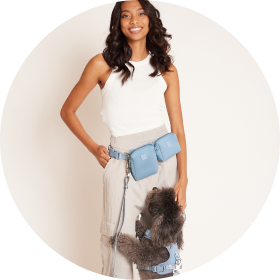- Home
- The Daily Wag!
- Senses
- Can Dogs Smell Cancer on Other Dogs?
Can Dogs Smell Cancer on Other Dogs?
Introduction
You've probably heard of dogs detecting cancer in people before, right? If you haven't, it's time to learn something new. Dogs' noses are so powerful that they're able to sniff out the changes in certain cells when people develop illnesses like cancer. So, it should be no surprise that dogs can sniff out cancer in other pups, too.
Because dogs' noses are so much more powerful than peoples - they have about 25 times more smell receptors than people do - they're able to sniff out the change in a dog's body composition and the changing cancer cells. A dog's brain is led by their olfactory cortex (it's about 40 times bigger than a human's olfactory cortex), which allows them to sniff out cancer cells in other dogs.
Check out some of the signs your dog might be giving you to let you know they're sniffing out cancer in another dog, how you can train your dog to be a cancer-detection pooch, and more information on the impressive power that your dog's nose has in our article below.
Signs Your Dog is Sniffing Out Cancer in Another Dog
You've likely read about the signs your dog will give you when they're sniffing out illness or cancer in a person, and unsurprisingly, many of those signs are the same for sniffing out cancer or illness in another dog. One of the biggest signs is your dog will spend an inordinate amount of time, attention, and affection on the dog who they smell the cancer on.
For example, pups are known to nuzzle the area on other dogs where they might be sniffing the cancer due to the distinct scent coming from that area.
Additionally, your dog might start to act strangely attentive, anxious, or protective of the animal with cancer. Your pup might try to get attention to the other dog to let someone - anyone - know what they know. This includes jumping, nudging, howling, barking, and other behavior changes that might occur.
History of Dogs Sniffing Out Cancer
While dogs being used to sniff out cancer on other dogs is less common, the idea behind using dogs to smell illness and cancer for people is not a new concept. The first time a dog was used to get a whiff of an illness was in a 1989 medical journal publication called The Lancet, where two dermatologists explained a case in which one of their patients sought medical attention because her dog wouldn't leave a mole on her upper leg alone.
As it turns out, this mole was cancerous and because of the dogs' insight, treatment was given immediately. In the next few decades following, more and more attention was shifted toward dogs sniffing out cancer. Empirical analysis since suggest that dogs have a 99 percent chance of accurately predicting lung cancer from the urine of afflicted patients, and further, other types of cancers. In fact, a group of researchers in Berlin trained a group of dogs to detect the presence of various cancers in people, including things like cervical, bladder, skin, lung, and ovarian cancer.
The Science Behind Dogs Smelling Cancer
Studies suggest that cancerous cells release a different metabolic waste product than other, healthy cells in both people and animals. Because of this, your dog, with his or her superhero smell ability, can tell the difference between cancerous cells and healthy cells.
The difference, in fact, is so evident to your pooch that your dog can detect cancer even in its earliest stages, which is why dogs have been employed by medical research groups to sniff out cancer in people. It's not so different with dogs. If your pup sniffs out cancerous smells for people, why wouldn't they be able to detect the change in cell smell in other dogs?
Training Your Dog to Sniff Out Cancer
If you think your dog might have an exceptional sniffer - more so than the normal dog - then you might consider having them properly trained to sniff out cancer. Because cancerous cells have a different scent due to their metabolic waste odor, a dog can be trained to detect the difference between healthy and cancerous cells in both people and other pets.
The smells given off by cancer cells can be detected through bodily fluids or breath, so a dog will need to be presented with hundreds of samples to get the training going. While you can possibly train your dog on your own to detect cancer, enrolling them in a certified program might be the best route in order to guarantee proper training.
Typically, a trainer will implement a play and reward system in order to train your doggo properly. This starts with playing with a specific toy with your dog as often as possible, creating play as a method of reward for your dog. Next, a trainer will introduce a scent to your dog where they're trained to detect it and it alone.
Once your dog is able to identify the scent correctly, they'll cement this command into their head with a reward-play based system. Next, they'll be able to teach your dog various scents, as well as introduce them to cancerous scents to begin detecting.
Written by a Great Dane lover Hanna Marcus
Veterinary reviewed by:
Published: 04/17/2018, edited: 04/06/2020
More articles by Hanna Marcus
